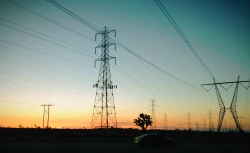
Transmission lines along Highway 15 outside Victorville, California. | Photo courtesy of Abby Rowling.
EDITOR'S NOTE: This article originally appeared on WhiteHouse.gov.
This week marks the tenth anniversary of one of the worst power outages in the United States, during which tens of millions of Americans were affected across parts of Ohio, Michigan, Pennsylvania, New York, Vermont, Massachusetts, Connecticut and New Jersey. Severe weather is the number one cause of power outages on the nation’s electric grid, which serves as the backbone of the nation’s infrastructure that delivers electric power to millions of Americans in homes, schools, offices and factories across the United States.
A new report from the White House Council of Economic Advisers and the Energy Department evaluates the economic cost of power outages and calls for increased cross-sector investment to make the electric grid more resilient in the face of increasingly severe weather events due to climate change.
The report provides new estimates of the annual cost of power outages caused by weather. Between 2003 and 2012, weather-related outages are estimated to have cost the U.S. economy an inflation-adjusted annual average of $18 billion to $33 billion. Annual costs fluctuate significantly and are greatest in the years of major storms such as Hurricane Ike in 2008, a year in which cost estimates range from $40 billion to $75 billion, and Superstorm Sandy in 2012, a year in which cost estimates range from $27 billion to $52 billion.
The costs of outages take various forms including lost output and wages, spoiled inventory, delayed production, inconvenience and damage to the electric grid. Continued investment in grid modernization and resilience will mitigate these costs over time – saving the economy billions of dollars and reducing the hardship experienced by millions of Americans when extreme weather strikes.
The report also identifies strategies for modernizing the grid to better prevent power outages, including working with utilities to harden their infrastructure against wind and flood damage, increasing overall robustness of the grid, and supporting implementation of 21st century technologies that can quickly alert utilities when consumers experience a power outage.
Investment in a 21st century modernized electric grid has been an important focus of President Obama’s administration. The President’s Climate Action Plan calls for upgrading the country’s electric grid to help make electricity more reliable, save consumers money on their energy bills, and promote clean energy sources.
In addition, the President’s “Policy Framework for the 21st Century Grid” set out a four-pillared strategy for modernizing the grid and directed billions of dollars toward investments in 21st century smart grid technologies, and the 2009 American Recovery and Reinvestment Act allocated $4.5 billion to the Energy Department for investments in modern grid technology.
These investments have begun to increase the resilience and reliability of the grid, but more investment is needed to ensure the grid can continue to power the economy in the face of severe weather. Learn more at smartgrid.gov.



